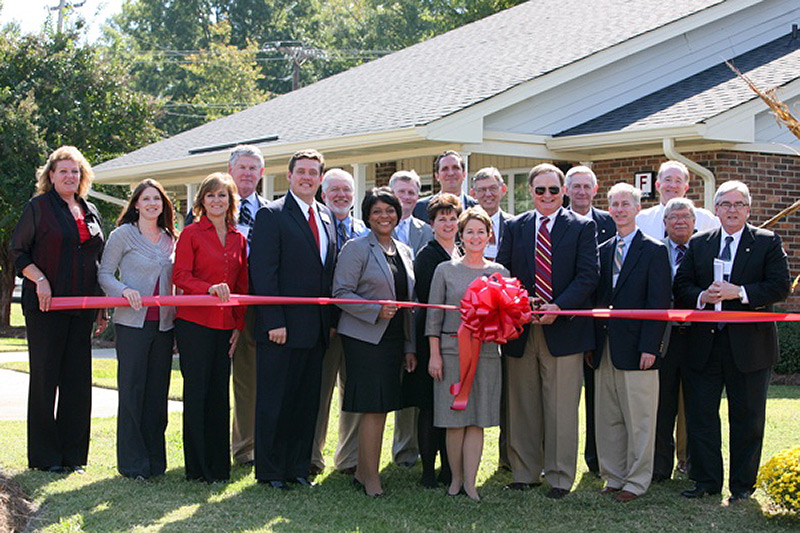- October 18, 2010
- Category: Renovations

SC Preservation: Changing a Community, One Town at a Time
Grand Opening Celebration; Tuesday, October 18th, 2010
Community can be defined “as a collection or group of people that interact and share something in common.” Community, as we see it can be broader than one neighborhood, one town, or even one county. In fact, the “common” factor in an unprecedented transaction that closed in late 2009 was the renovation and preservation of 1,548 aged affordable housing units for residents all across the state of South Carolina.
WWJ, LLC, an affiliate of Boyd Management, Inc., recently continued with their major initiatives to preserve and upgrade their existing 300+ RD 515 affordable housing projects located throughout the small rural markets of Georgia, North Carolina, and South Carolina. To our knowledge, affordable housing preservation of this magnitude, completed in a single transaction, had never been attempted, much less accomplished … until now. WWJ joined forces with Greystone Affordable Housing Initiatives, LLC (GAH) to determine how best to accomplish their goal in a timely and financially feasible manner, while also maximizing community impact on the small rural markets. WWJ provided construction, property management, and compliance expertise, while GAH provided the development, transaction management and financial expertise needed to make such a colossal mission possible. Together, WWJ, GAH, Community Affordable Housing Equity Corporation (CAHEC), United States Department of Agriculture Rural Development, and the South Carolina Housing Finance and Development Authority determined that there was a significant need and demand for quality, affordable housing across the South Carolina “community” and worked diligently to complete the largest RD 515 portfolio transaction to date – anywhere. The transaction closed on September 25, 2009, and impacted not just one local community, but 41; not only affected one rural county, but crossed into 23 different counties. 41 different buyers and 45 different sellers (four properties were consolidated at the time of transfer) were pooled together into one transaction, resulting in a total of 41 projects or 1,548 units preserved for another 30 years.
The various projects reside in towns that are designed rural. In most cases, these communities have not had any multi-family property renovations completed in years, leaving local residents with limited housing options. While the specific projects included in this transaction have been well maintained overall, they were showing significant signs of their age and were becoming obsolete. All the towns welcomed the opportunity to have a property in their town selected to be part of the 2009 SC Preservation Portfolio. Local Chambers of Commerce, Mayors, Congressional Representatives, and many other community leaders and members all gathered to support this endeavor and have since further embraced the grand results by helping to celebrate the rehab completions. Just as these rural communities have not had a major property makeover in years, for many of the residents, this was the first time they have ever had the opportunity to live in a “like new” home. Tremendous efforts by all resulted in beautifully renovated, affordable housing properties that the community and residents could proudly call “Home”!
Even during the worst capital market experienced by the affordable housing industry in decades, WWJ, GAH, and other participating professionals invested tremendous dollars into the rural communities for their preservation efforts. Total development costs for the acquisition and rehab of the portfolio were approximately $113.5 million, averaging more than $73,000 per unit. $22,000 per unit (average) was invested in hard costs alone, with the total construction contracts exceeding over $38 million. Every property was fully renovated, allowing new owners to bring the property into full accessibility compliance. Rehabilitation included a comprehensive interior and exterior renovation, including the replacement of windows, siding, roofs, exterior doors, and attic insulation. Kitchens were updated with brand new solid wood kitchen cabinets, faux granite countertops, sinks, faucets, and appliances. Changes to bathrooms included new vanities, flooring, sinks, bathtubs, toilets, and fixtures. Old HVAC units were replaced with newer, energy efficient models. Additional smoke detectors, fire extinguishers, range queens, and community security systems were added for additional residents’ safety. Many of the properties which had original polybutylene piping had it replaced with CPVC or PEX pipe. Ceiling fans and additional lighting fixtures were also added to many.
Other amenities were incorporated for the residents, including common laundry rooms. Curb appeal was enhanced by adding new landscaping, sprinkler systems, signage, playgrounds, gazebos, fencing, and new parking lots. The onsite offices received new furniture and were remodeled with a more updated look.
When construction was completed in just over 1 year for all 41 projects, management saw an immediate change in the attitude of its residents, applicants and employees. Residents took pride in their homes by improving housekeeping standards and purchasing new furniture and décor. Applications flooded the offices as the word of the rehabs spread through the local communities, and waiting lists are building. Management and maintenance staff employees are proud of their like-new apartments and surroundings to sell.
